Catocala manitoba
Catocala praeclara manitoba
kah-TOCK-uh-lahmpree-CLAIR-uhmman-ih-TOH-buh
Beutenmüller, 1908

Catocala praeclara manitoba from Barnes & McDunnough Plate
This site has been created by
Bill Oehlke at oehlkew@islandtelecom.com
Comments, suggestions and/or additional information are welcomed by Bill.
| TAXONOMY:
Superfamily: Noctuoidea
Family: Noctuidae
Group: Noctuinina
Subfamily: Catocalinae
Genus: Catocala, Schrank, 1802
| |
MIDI MUSIC
"Moon River"
copyright C. Odenkirk
MIDI CITYON.OFF
<bgsound src="moon.mid" LOOP=FOREVER>
|
DISTRIBUTION:
Catocala praeclara manitoba
(wingspan: mm), flies in Montana, and in Canada in
Alberta, Saskatchewan and Manitoba.
This moth is now (2010) treated as a subspecies of praeclara.
FLIGHT TIMES AND PREFERRED FOOD PLANTS:
Catocala praeclara
manitoba flies as a single
generation with moths on the wing from .
The Catocala praeclara manitoba caterpillar feeds on poplar and willow.
ECLOSION:
Adults eclose from pupae formed under leaf litter.
SCENTING AND MATING:
Catocala praeclara manitoba females
emit an airbourne pheromone and males use their antennae to track the
scent plume.
EGGS, CATERPILLARS, COCOONS, AND PUPAE:
Eggs are deposited on tree bark in the fall and hatch the following spring.
Mature larvae Image courtesy of |
 |
Larval Food Plants
Listed below are primary food plant(s) and alternate food plants.
It is hoped that this alphabetical listing followed by the common
name of the foodplant will prove useful. The list is not exhaustive,
although some species seem very host specific.
Experimenting with closely related foodplants is worthwhile.
This page is brought to you by Bill Oehlke and the
WLSS. Pages are on space rented from Bizland. If you would like to become a "Patron of the Sphingidae/Catocala Sites",
contact Bill.
Please send sightings/images to Bill. I will do my best to respond to requests for identification help.
Enjoy one of nature's wonderments: Live Saturniidae (Giant Silkmoth) cocoons.

|

To show appreciation for this site, click on the flashing
butterfly to the left, a link
to many worldwide insect sites. |


